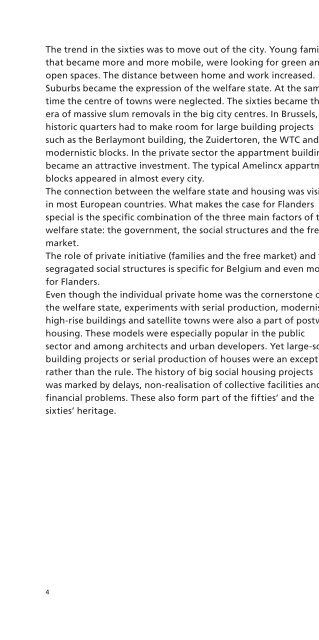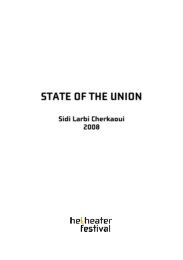Programmaboekje : Wonen in welvaart - deSingel
Programmaboekje : Wonen in welvaart - deSingel
Programmaboekje : Wonen in welvaart - deSingel
Create successful ePaper yourself
Turn your PDF publications into a flip-book with our unique Google optimized e-Paper software.
The trend <strong>in</strong> the sixties was to move out of the city. Young families,<br />
that became more and more mobile, were look<strong>in</strong>g for green and<br />
open spaces. The distance between home and work <strong>in</strong>creased.<br />
Suburbs became the expression of the welfare state. At the same<br />
time the centre of towns were neglected. The sixties became the<br />
era of massive slum removals <strong>in</strong> the big city centres. In Brussels,<br />
historic quarters had to make room for large build<strong>in</strong>g projects<br />
such as the Berlaymont build<strong>in</strong>g, the Zuidertoren, the WTC and<br />
modernistic blocks. In the private sector the appartment build<strong>in</strong>g<br />
became an attractive <strong>in</strong>vestment. The typical Amel<strong>in</strong>cx appartment<br />
blocks appeared <strong>in</strong> almost every city.<br />
The connection between the welfare state and hous<strong>in</strong>g was visible<br />
<strong>in</strong> most European countries. What makes the case for Flanders<br />
special is the specifi c comb<strong>in</strong>ation of the three ma<strong>in</strong> factors of the<br />
welfare state: the government, the social structures and the free<br />
market.<br />
The role of private <strong>in</strong>itiative (families and the free market) and the<br />
segragated social structures is specifi c for Belgium and even more<br />
for Flanders.<br />
Even though the <strong>in</strong>dividual private home was the cornerstone of<br />
the welfare state, experiments with serial production, modernistic<br />
high-rise build<strong>in</strong>gs and satellite towns were also a part of postwar<br />
hous<strong>in</strong>g. These models were especially popular <strong>in</strong> the public<br />
sector and among architects and urban developers. Yet large-scale<br />
build<strong>in</strong>g projects or serial production of houses were an exception<br />
rather than the rule. The history of big social hous<strong>in</strong>g projects<br />
was marked by delays, non-realisation of collective facilities and<br />
fi nancial problems. These also form part of the fi fties’ and the<br />
sixties’ heritage.<br />
4 5
















